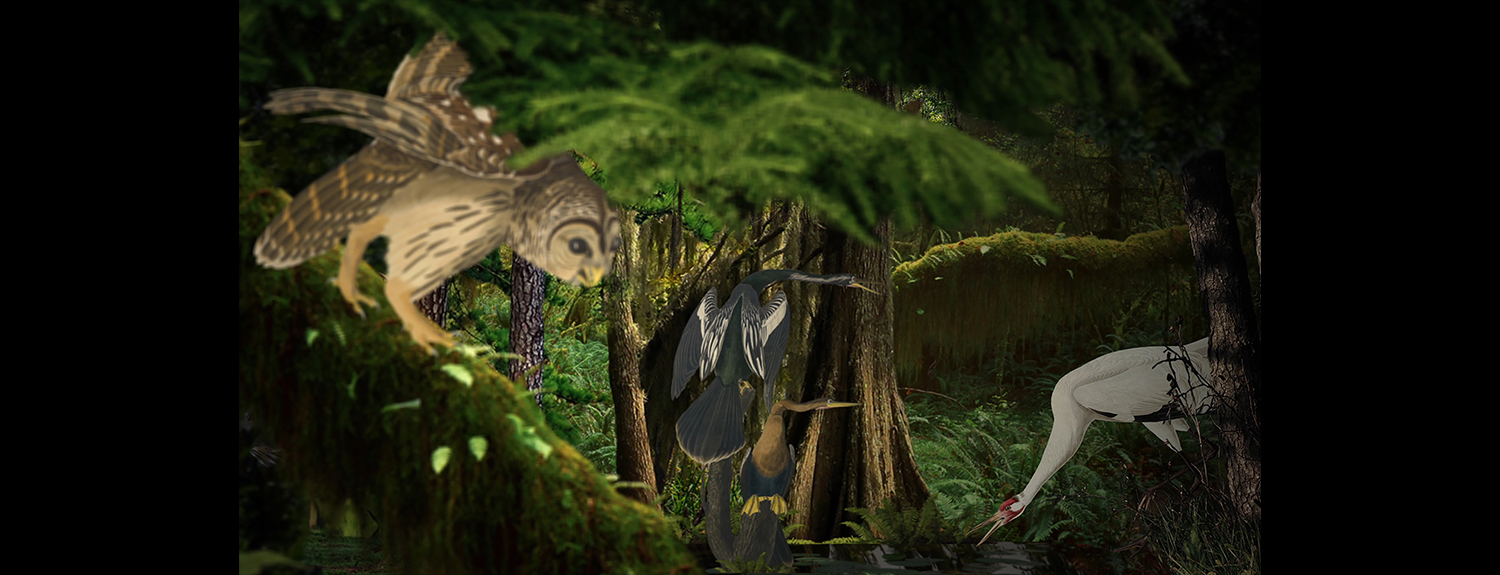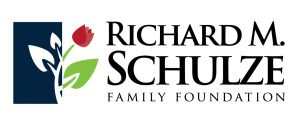
Audubon Animated NEWS
Audubon Animated, on view through May 31
The Bell Museum’s Latest Art and Science Exhibition Debuting Jan. 25 is a Real Tweet
Audubon Animated brings John James Audubon’s works to life in an immersive multi-media exhibit; the Bell also owns one of the artist’s rare “Birds of America” folios, with select works from this collection on display
IMAGES FOR PRESS AVAILABLE HERE
- PAUL, Minn. (Jan. 21, 2020) – The Bell Museum, Minnesota’s official natural history museum, today announced its newest exhibition of works that combine science and art, Audubon Animated, which will run Jan. 25 through May 1, 2020.
The exhibition is an immersive multimedia experience of birds and their habitats, as painted by John James Audubon in his monumental project, Birds of America. The Bell visitors will see and hear 20 different bird species, including some now extinct and threatened, as they fly, hunt, and preen over the course of a compressed day and night in a virtual habitat combining marshy Louisiana swamplands and Midwestern forest. The animation was created by OLO creative farm, a production company in Como, Italy, commissioned by the Indianapolis Museum of Art in 2017. Audubon images courtesy of Joel Oppenheimer, Inc. Immersive sound design by notclub; technical support by Ezra Birt.
“The Audubon Experience is a unique, walk-in, immersive experience using Audubon’s art, animated in an environmental setting,” says Don Luce, Bell curator of exhibits. “This exhibit is a great way for the Bell’s visitors to fly through winter and welcome the spring migrations of the many birds that we see in Minnesota during warmer months.”
The Bell’s exhibition also includes a selection of recently conserved prints from the museum’s rare double elephant folio of Birds of America, one of fewer than 120 in the world, as well as interpretive panels on Audubon’s works, life, and travels.
As further testament to the Bell’s commitment to natural sciences, scientific research and art, its beautiful new building, which relocated to its current University of Minnesota St. Paul campus location from its previous Minneapolis campus location in July 2018, was designed with bird-friendly glass.
Throughout the Audubon Animated exhibition, the Bell will also offer a wide variety of related events and activities centering on bird themes, as follows:
Resident Artist Featured Work: ongoing throughout the exhibit dates
Donald Thomas, a 2019-20 Bell resident artist, is creating an affirmation mirror centered on a life-sized eagle form with a nearly 8-foot wingspan. The work, built from wood, fabric, yarn, metal, mirrors, and paint, is titled A Bird’s-Eye View of Climate Change.
Thomas has spent a lot of time observing eagles in the wild with family and friends, and he feels a special connection with the birds. He says the work will reflect the relationship between rivers and climate change, with eagles representing nature’s view of climate change.
“I think we look at climate change a lot through our lens and how it affects us, but if we looked at it through the lens of the rivers, the forests, and the animals, we would have a very different relationship—at least I would hope that we would,” Thomas said of the project.
After Hours – Birds: March 18, 5-8:30 p.m.
The Bell offers evening hours one Wednesday per month. The March night will have a bird theme. Free activities with gallery admission include:
- Bird-focused diorama tours at 6:15 p.m. and 7:15 p.m.
- Bird themed sketching – b, using Audubon’s grid-based techniques
- Birds Through Dakota Eyes at 7 p.m.
Čhaŋtémaza (Neil McKay), University of Minnesota senior Dakota language specialist, will lead a talk about birds in Dakota language and culture.
- Whitney and Elizabeth MacMillan Planetarium show, Flying on Other Worlds, 6 p.m. and 7 p.m.
(Note: This show is a project created and presented by members of the Bell’s student staff.) What would it be like to fly on a world with 1/8 the gravity of Earth in an atmosphere five times as thick as the Earth’s? Why would we want to fly on a moon that’s a billion miles away, anyway? Follow along on a journey through time and space as we explore the history of flight on Earth and where humans are headed in the future. Travel with us as we explore the science and tools used to get to the bottom of such a foreign environment. Help us unmask the mystery of flight on Titan.
Yoga: Feb. 22, March 28, April 25 at 8:30-9:30 a.m. all dates
Held inside the Audubon Animated immersive video installation, these 60-minute gentle hatha-style classes, led by Instructor Rachel Holdgrafer of Peaceful Mind Yoga, include movements inspired by birds, a bird-themed guided relaxation, and meditation accompanied by birdsong. The classes are suitable for ages 10 and up, and all levels of yoga experience and ability.
Tickets are $20 for adults and $10 for kids ages 10–18. Gallery admission is not included in yoga ticket price. Advance registration is required and space is limited.
Bird-themed diorama tours – select dates/times outlined below
Guided tours of the Bell’s signature wildlife dioramas, focusing on the bird displays, will be held during the museum’s monthly “After Hours” nights throughout the installation on Feb. 19, March 18, April 15 and May 20 at 6:15 p.m. and 7:15 p.m., and on the following Sundays during the installation: February 16, March 15, April 19 and May 17 at 1:30 p.m. The diorama tours are free with gallery admissions.
About Bell Museum
The Bell Museum is Minnesota’s official natural history museum, established by the state’s legislature in 1872 and held in trust by the University of Minnesota. For over a century, the museum has preserved and interpreted the state’s rich natural history and served learners of all ages. Additionally, its scientific collections contain over a million specimens, representing every county in Minnesota and various locales around the globe. Located on the University of Minnesota’s St. Paul campus, the museum features a state-of-the art digital planetarium, high-tech exhibits, famous wildlife dioramas, outdoor learning experiences and more. The Bell’s University of Minnesota organizational home is within the College of Food, Agricultural and Natural Resource Sciences, which comprises 13 academic departments and 10 research and outreach centers, along with the Bell Museum, Minnesota Landscape Arboretum, and dozens of interdisciplinary centers. For more information, visit bellmuseum-staging.smx6mahh-liquidwebsites.com/
Generously supported by

###
For more information, contact
Mary Haugen
Haugen Public Relations, for the Bell Museum
612-201-0697
Background on Audubon and Bell’s Folio of His Works
In 1826, John James Audubon set out to publish a collection of engravings of every known bird species in North America. In the early 19th century, ornithological art showed birds in stiff profile, drawn from stuffed specimens. Audubon traveled the United States with his sketch pad, drawing from life and posing freshly killed birds as models. His resulting collection, entitled Birds of America, showed birds flying and eating, courting and killing. His project was not only audacious, but also revolutionary.
“Birds of America is full of action and full of drama. And this was completely unprecedented before Audubon,” Don Luce, curator of exhibits at the Bell Museum. “He imbues the birds with a lot of character and emotion that a naturalist might not really appreciate, but the public loved it. And it changed people’s attitudes about birds. It made people recognize that birds had a life. They had stories and they did interesting things.”
Audubon wanted to show the birds life-size, so he had his paintings reproduced as hand-colored, copper engravings on the largest paper available, known as double elephant. The 435 prints were bound as four volumes, measuring 2 by 3 feet and weighing 200 pounds.
The Bell’s original double elephant folio of Birds of America was donated to the museum in 1928 by William Overton Winston, a railroad contractor who displayed it at his summer house on Lake Minnetonka. It is one of perhaps 120 complete sets in existence. The Minneapolis Athenaeum also owns a copy, housed at Minneapolis Central Library.
###

